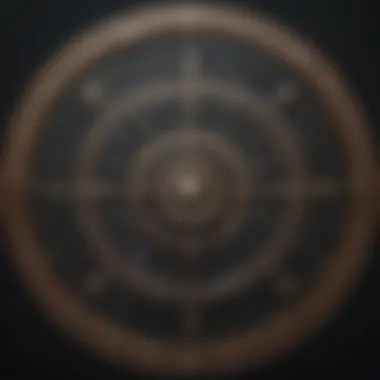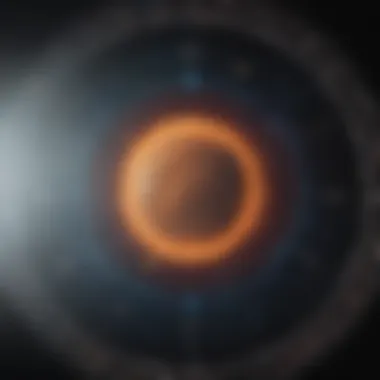Exploring Astrological Compatibility through Natal Charts


Intro
Astrological compatibility is a fascinating field that intertwines with personal relationships. With the aid of natal charts, individuals can gain insights into how they connect with others on a deeper level. Each chart introduces a unique blend of elements, offering clarity about the dynamics that can flourish or falter between partners.
Understanding the role of sun signs, moon signs, and rising signs is crucial. These components provide a framework for analyzing compatibility. Moreover, planetary placements contribute significantly to one's relational behaviors. By dissecting these facets, we can assess compatibility in love, friendships, and even workplace interactions.
This section of the article will explore these elements in depth, outlining how to interpret and apply this astrological knowledge effectively.
Zodiac Profiles
Overview of Each Sign
The zodiac consists of twelve signs, each with specific attributes that shape individual personalities. Below is a summary of each sign:
- Aries: Energetic and assertive, Aries often takes the lead. They are adventurous and spontaneous.
- Taurus: Known for their reliability, Taurus enjoys stability and luxury. They can be stubborn.
- Gemini: Curious and adaptable, Gemini thrives on social interactions but can be indecisive.
- Cancer: Emotionally driven, Cancer values deep connections and security in relationships.
- Leo: Charismatic and confident, Leo seeks recognition and thrives in the spotlight.
- Virgo: Analytical and detail-oriented, Virgo aims for perfection and practicality.
- Libra: Diplomatic and fair-minded, Libra seeks harmony and balance in relationships.
- Scorpio: Intense and passionate, Scorpio has a profound emotional depth and a unique sense of loyalty.
- Sagittarius: Independent and philosophical, Sagittarius values freedom and exploration.
- Capricorn: Discipline and ambition define Capricorn, often seen as responsible and traditional.
- Aquarius: Innovative and unconventional, Aquarius thinks outside the box but may seem detached.
- Pisces: Sensitive and creative, Pisces is empathetic and often has a vivid imagination.
Personality Traits
Understanding personality traits can help reveal how partners interact. Some key traits include:
- Aries: Leader, enthusiastic, impulsive.
- Taurus: Reliable, sensual, stubborn.
- Gemini: Communicative, adaptable, superficial.
- Cancer: Nurturing, intuitive, moody.
- Leo: Generous, theatrical, arrogant.
- Virgo: Practical, detail-oriented, critical.
- Libra: Charming, indecisive, superficial.
- Scorpio: Passionate, secretive, jealous.
- Sagittarius: Optimistic, adventurous, reckless.
- Capricorn: Ambitious, disciplined, pessimistic.
- Aquarius: Visionary, aloof, unpredictable.
- Pisces: Compassionate, artistic, escapist.
Strengths and Weaknesses
Each sign has inherent strengths and weaknesses that influence compatibility:
- Aries: Strengths include leadership; weaknesses are impatience.
- Taurus: Strengths include loyalty; weaknesses are possessiveness.
- Gemini: Strengths include versatility; weaknesses are inconsistency.
- Cancer: Strengths include empathy; weaknesses are insecurity.
- Leo: Strengths include creativity; weaknesses are pride.
- Virgo: Strengths include reliability; weaknesses are over-critical.
- Libra: Strengths include diplomacy; weaknesses are indecision.
- Scorpio: Strengths include intensity; weaknesses are jealousy.
- Sagittarius: Strengths include optimism; weaknesses are recklessness.
- Capricorn: Strengths include determination; weaknesses are rigidity.
- Aquarius: Strengths include innovation; weaknesses are aloofness.
- Pisces: Strengths include creativity; weaknesses are escapism.
Compatibility Insights
Love and Relationships
In romantic contexts, each zodiac sign functions best with specific counterparts. Analyzing sun and moon signs can offer insights into emotional and communicative compatibility. Relationships thrive when partners share core values and respect each other’s needs.
Friendship Compatibility
Friendship dynamics can also be enhanced by understanding natal charts. Signs that naturally align often experience a smoother interaction, fostering deeper connections. Traits like loyalty, humor, and empathy determine friendship longevity and strength.
Workplace Dynamics
In professional environments, compatibility plays a crucial role in teamwork and collaboration. Certain combinations yield productive partnerships, while others may need balance. Recognizing how strengths and weaknesses affect work relationships is beneficial.
Astrological Events
Monthly/Weekly Horoscope Breakdown
Horoscope readings provide insights into ongoing astrological influences. Regular evaluations can help individuals navigate challenges and capitalize on opportunities.
Notable Celestial Events
Celestial events, like retrogrades and eclipses, significantly affect natal charts. Awareness of these occurrences can optimize personal and relational outcomes.
How to Prepare for Astrological Shifts
Preparation involves understanding upcoming astrological shifts and their potential impact. Harnessing this knowledge can lead to proactive measures in both personal and social contexts.


By acknowledging the complexities of astrological compatibility, individuals can develop richer, more fulfilling relationships. Natal charts serve as a roadmap for understanding oneself and one’s partners.
Foreword
Astrological compatibility offers a unique framework for understanding the dynamics of relationships. By examining natal charts, individuals can gain insights into personality traits, emotional needs, and potential conflicts. This exploration aids in navigating the complexities that arise in partnerships. The importance of this investigation lies in its ability to illuminate relational patterns and provide guidance for personal growth.
The Relevance of Astrology in Relationships
Astrology has long been associated with human behavior and interpersonal connections. Many believe that celestial movements influence our lives profoundly. When considering relationships, astrology not only sheds light on compatibility but also enriches our understanding of personal dynamics.
For various people, astrology offers a lens to view their relationships. By analyzing how individual energies intersect, one can make informed choices and develop healthier interactions. Many practitioners and enthusiasts utilize astrological insights to address challenges, promote communication, and deepen connections.
"Astrology is the science of the relations of the planets, which signifies the relation between the positions of celestial bodies and events on Earth."
This emphasizes the core idea that astrological influences shape our emotional and relational landscapes.
Defining Natal Charts
Natal charts are personalized blueprints reflecting the positions of celestial bodies at one’s birth time. Each chart contains several elements, including sun, moon, and rising signs. These components symbolize distinct aspects of personality: the sun sign represents core identity, the moon sign indicates emotional responses, and the rising sign illustrates outward behavior.
A natal chart is divided into twelve houses, each representing different life areas, like career or relationships. The arrangement of planets within these houses reveals deeper insights about an individual's motivations, challenges, and strengths. By understanding one's own chart, along with their partner's, individuals can uncover compatibility factors that might influence their relationship.
In summary, natal charts serve as invaluable tools for exploring astrological compatibility. The detailed understanding of these charts not only fosters personal insight but also catalyzes more meaningful interactions in relationships.
Understanding Natal Charts
Understanding Natal Charts is a crucial part of this article. Natal charts are personalized, unique maps of the sky at the time of an individual's birth. They provide insights into personality traits, motivations, and potential life paths. Each various part of the natal chart interacts to shape who a person is and how they relate to others. This understanding is vital when exploring astrological compatibility between partners. Knowing one's own and their partner's natal charts helps illuminate relational dynamics.
Components of Natal Charts
Sun Signs
Sun Signs represent the core essence of an individual's personality. This aspect provides insight into basic traits and tendencies. For many, Sun Signs are the first thing they learn about astrology. They reveal vital information about a person's identity and will. Sun Signs are prevalent in astrology, making them a key element in this article. They are easily relatable and provide a quick understanding of someone's character.
However, relying solely on Sun Signs can be limiting. While they are vital, they do not encompass the full complexity of personality. A Sun Sign alone cannot offer a complete picture of one's compatibility with another person.
Moon Signs
Moon Signs delve deeper into emotional responses and subconscious behavior. They reveal how individuals deal with feelings and handle their inner world. Moon Signs are critical in understanding an emotional bond between two people. By examining their Moon Signs, partners can learn about each other's emotional needs and instincts. This aspect of compatibility is essential, especially in long-term relationships.
The unique nature of Moon Signs can also present challenges. A partner may have a moon Sign that conflicts with the other’s, leading to misunderstandings. Yet, recognizing these differences can lead to deeper connection when viewed constructively.
Rising Signs
Rising Signs, or Ascendant Signs, represent how individuals present themselves to the world. They influence first impressions and social interactions. Understanding the Rising Sign can explain why two people may have initial chemistry, despite differences in other areas.
The key characteristic of Rising Signs is that they often highlight traits not found in the Sun or Moon Signs. A diverse Rising Sign can complement a partner's personality, enhancing compatibility. However, relying too heavily on this feature without considering the deeper layers of a natal chart can create superficial conclusions about a pairing.
Astronomical Influences
Astrological compatibility is also significantly affected by various astronomical influences. These influences include the positions of planets at the time of birth. Each planet carries specific energies and traits. For instance, Venus influences love and relationships while Mars relates to passion and aggression. A natal chart incorporates these relationships into its analysis.
The placement and movement of these celestial bodies create intricate dynamics in relationships. Individuals may discover powerful resonances or notable friction when analyzing their or their partner’s charts. Understanding these influences can illuminate potential strengths or challenges that may exist in a relationship.
Overall, understanding natal charts provides a roadmap for exploring compatibility. It highlights how each individual's personality can either enhance or obstruct their connection with others. By decoding these intricate relationships, one can gain valuable insights that foster personal and relational growth.
Astrological Compatibility


Astrological compatibility serves as a core aspect of this article, focusing on the connections between individuals based on their natal charts. It is essential for understanding the dynamics that may unfold in relationships. Each natal chart acts as a map, uniting celestial bodies and their positions at the time of birth. By analyzing these charts, we gain insight into how different personality traits align or clash. The significance of this analysis is not just theoretical but practical, offering us potential guiding strategies for personal and relational growth.
The Basis of Compatibility Analysis
At the heart of compatibility analysis is the understanding that every astrological element affects personal interactions. Individual sun signs denote essential traits, while moon signs reveal emotional landscapes. Rising signs contribute an additional layer of perspective, shaping how we present ourselves to the world. The synthesis of these components forms the basis for determining compatibility between partners. Observing interactions among these elements outlines strengths and challenges that may manifest in relationships.
Key Factors in Compatibility
Elemental Relationship
The elemental relationship refers to the four primary elements in astrology: fire, earth, air, and water. Each element encompasses specific characteristics and affinities which can significantly influence compatibility. For instance, fire signs like Aries, Leo, and Sagittarius are inherently passionate and dynamic, often seeking excitement. Earth signs such as Taurus, Virgo, and Capricorn possess stability and practicality, which can be grounding for the more impulsive fire signs. This interaction between elements can support or hinder relationships depending on their combinations.
The unique feature of elemental compatibility is its ability to highlight fundamental differences. Understanding these elemental dynamics helps individuals recognize inherent traits, reducing misunderstandings. However, this perspective can also have disadvantages. For example, two fire signs might generate intense passion, leading to conflicts if both are unwilling to compromise. Thus, recognizing the elemental relationship allows for a clearer outlook into the emotional and functional aspects of connections.
Modal Dynamics
Modal dynamics relate to the three modalities present in astrology: cardinal, fixed, and mutable. These modalities present how individuals initiate actions and respond to their environments. Cardinal signs, like Aries and Libra, are initiators, while fixed signs such as Taurus and Scorpio tend to seek stability, and mutable signs like Gemini and Sagittarius are adaptable and flexible. This disparity provides insight into relational styles and preferences.
A significant contribution of modal dynamics is its reflection of personal approaches to challenges and change. Modal dynamics can enhance compatibility by illuminating how partners navigate conflicts and growth opportunities. A challenge arises when strong modalities clash; for instance, a cardinal sign may push for change while a fixed sign resists it. Understanding modal dynamics helps foster more harmonious interactions, emphasizing the importance of flexibility and perspective.
Planetary Aspects
Planetary aspects are crucial in predicting relational compatibility, as they describe angles formed between planets within the natal charts. The most notable aspects include conjunctions, trines, squares, and oppositions which indicate how planets interact. For example, a conjunction suggests enhanced cooperation between two planetary influences, fostering smooth communication.
The key characteristic of planetary aspects is their ability to reveal intricate details about relationship dynamics. Assessing these relationships provides richer insights into how partners collaborate and contend with one another, while recognizing the potential for growth. A disadvantage, however, can be an overemphasis on challenging aspects that may overshadow positive connections, leading to potential misinterpretations of compatibility.
Through a balanced exploration of astrological elements, including elemental relationships, modal dynamics, and planetary aspects, individuals can better understand their connections. By focusing on these crucial factors, partners can learn to cultivate healthier dynamics, leading to a more enriching relational experience.
Analyzing Compatibility in Natal Charts
Analyzing compatibility in natal charts is essential for those interested in astrology, particularly in how individuals relate to one another. Understanding compatibility through natal charts allows for a more nuanced view of relationships, rather than relying on vague generalizations about sun signs alone. Each person's natal chart encompasses complex dynamics that reflect their personality traits, emotional depth, and interpersonal interactions. This analysis can help partners identify areas of synergy and potential challenges, enriching their relationships.
Furthermore, this compatibility analysis facilitates deeper conversations and promotes personal growth. It illuminates not just the strengths but also the weaknesses within partnerships, creating opportunities for constructive dialogue. By focusing on specific astrological elements, individuals can gain insights into how they can better support each other. This makes the analysis particularly relevant for astrological enthusiasts seeking holistic life approaches.
Step-by-Step Analysis
The step-by-step analysis of natal charts for compatibility involves several key steps that can guide individuals through the assessment process. Here are the main components to consider:
- Collect Birth Data: Gather accurate birth dates, times, and locations for both partners. This information is critical for creating precise natal charts.
- Generate Natal Charts: Use astrology software or online tools to generate the natal charts for both individuals. Ensure that the birth data is correctly inputted.
- Identify Key Components: Focus on elements such as sun signs, moon signs, and rising signs. Each component provides distinct insights into personality and emotional responses.
- Compare Planetary Positions: Examine the positions of planets in each chart. Look for harmony or tension in aspects such as conjunctions, squares, and trines.
- Elemental and Modal Analysis: Assess the elemental balance (fire, earth, air, water) and modalities (cardinal, fixed, mutable) to further understand compatibility dynamics.
- Summarize Findings: After comparing key elements, summarize the results. Identify areas where the partners align and where difficulties may arise, forming a cohesive understanding of relationship compatibility.
Common Compatibility Pairings
In astrology, certain pairings are deemed more compatible based on specific characteristics of their natal charts. Here are a few common compatibility pairings often explored:
- Fire & Air Signs: Aries, Leo, and Sagittarius tend to pair well with Gemini, Libra, and Aquarius due to their dynamic interactions and mutual enthusiasm.
- Earth & Water Signs: Taurus, Virgo, and Capricorn often find compatible matches with Cancer, Scorpio, and Pisces, as they create nurturing and grounded relationships.
- Same Element Pairings: Partners sharing the same element, like two earth signs or two fire signs, can foster a deep understanding and common ground.
- Modal Compatibility: Cardinal signs (Aries, Cancer, Libra, Capricorn) often work well with each other, just as fixed signs (Taurus, Leo, Scorpio, Aquarius) or mutable signs (Gemini, Virgo, Sagittarius, Pisces) create balance and stability among themselves.
Ultimately, the analysis of compatibility in natal charts requires careful consideration of these factors. By comprehensively understanding these dynamics, individuals can enhance their relationships and navigate challenges with greater awareness.
Challenges in Astrological Compatibility
Astrological compatibility is a complex topic. While it offers insights into relationships, there can be significant challenges. Analyzing natal charts involves understanding not just the positive aspects of compatibility but also the hardships that can arise.
The importance of addressing these challenges is multifaceted. Firstly, recognizing the difficult aspects of a relationship can help partners navigate their differences. It provides a clearer picture of potential tensions and conflicts, which can lead to effective conflict resolution strategies. Secondly, these challenges often illuminate areas of growth for individuals. By acknowledging issues in the relationship dynamic, partners can cultivate personal development, making the relationship more resilient overall.
Most significant aspects to consider when discussing challenges in astrological compatibility include:


- Planetary placements: Some planetary alignments can signify discord, which needs understanding.
- Elemental differences: Certain elemental combinations might naturally clash, creating friction.
- Modal imbalances: Modal dynamics can affect how partners express themselves, sometimes leading to misunderstandings.
This exploration of challenges highlights the need for an informed approach to the interplay of astrological compatibility.
Handling Difficult Aspects
Difficult aspects in natal charts can signal areas where both partners might struggle. Such aspects often reveal conflicts that can emerge repeatedly. They can stem from how planets interact, such as squares or oppositions. Partnership dynamics can feel intense, leading to feelings like frustration or misunderstanding.
To manage these difficulties, it is essential to adopt specific strategies:
- Open communication: Partners should express feelings and concerns.
- Understanding natal influences: Knowing one’s natal chart can equip partners to identify triggers.
- Seeking external guidance: Sometimes, consulting an astrologer can offer deeper insights into challenges.
Understanding these aspects and how they manifest in relationships is crucial. The key lies in viewing conflicts as opportunities for growth rather than insurmountable barriers.
Identifying Red Flags
Red flags in astrological compatibility often reveal underlying issues that may not be easily seen. These flags can present themselves through conflicting sun, moon, or rising signs, which may lead to unmet emotional needs. For example, if one partner's moon is in a sign that craves stability, while the other's sun sign leads to impulsive behavior, it can create substantial friction.
To effectively identify these red flags, partners should be mindful of the following:
- Persistent disagreements: Repeated arguments on the same themes can signal deeper compatibility issues.
- Lack of emotional connection: If one partner feels emotionally alienated or disconnected, it can indicate a problem.
- Avoidance of confrontation: If one partner tends to evade disputes, it might point towards an underlying fear of conflict due to astrological aspects.
Being aware of these flags allows partners to proactively address issues and promote healthier relationship dynamics. Recognizing these early can prevent deeper problems down the line.
Practical Applications of Natal Chart Compatibility
Understanding the practical applications of natal chart compatibility is vital for both personal development and relationship enhancement. Astrology is not merely a tool for predicting fortunes; it can provide profound insights into our relational dynamics, fostering empathy and understanding between partners. By recognizing how different natal chart components interact, individuals can gain clarity in their relationships.
Using Astrology for Relationship Guidance
Astrology can serve as a valuable guide in navigating romantic relationships. By examining the placement of planets and their aspects within each partner's natal chart, key insights emerge about strengths and potential conflicts. For instance, the connection between sun signs can indicate essential compatibility, but a deeper dive into moon signs and rising signs often reveals how emotional needs and outward personalities may align or clash.
This astrological analysis serves several beneficial purposes:
- Conflict Resolution: Understanding contrasting traits can facilitate better communication.
- Enhancing Romantic Bonds: Recognizing strengths fosters appreciation and romantic connection.
- Tailored Strategies: Each pairing can take its unique characteristics into account when making decisions, reducing misalignment.
In exploring compatibility, couples can work through challenges with greater awareness. This approach encourages open dialogue about both individuals' needs, ultimately leading to deeper intimacy.
Personal Growth through Astrology
Utilizing natal charts extends beyond relationship improvement; it can also contribute significantly to individual growth. Engaging with one's own chart raises self-awareness, showcasing personal tendencies and behavioral patterns. By recognizing these attributes, individuals can work on areas needing development. For example, if a person finds challenging aspects between their own planets, this reflects inner conflicts that may require attention.
Moreover, examining a partner's chart in relation to one's own can create opportunities for profound personal insights. The journey together might reveal:
- Self-Reflection: Understanding how external factors influence personal decisions and emotions.
- Adaptive Change: Identifying key challenges can promote resilience and adaptability.
- Inclusive Growth: Engaging in growth journeys together fosters collective wisdom and connection.
Through practical applications of natal chart compatibility, the interplay of relational and personal insights creates a compelling framework for growth. This enables partners to not only thrive together but also as individuals. Ultimately, the structured insights gained from astrology can lay a significant foundation upon which to build fulfilling relationships.
Finale
In this article, we explored the importance of astrological compatibility through the lens of natal charts. Understanding how different elements within a natal chart interact can provide significant insights into relationship dynamics. Each component, be it sun signs, moon signs, or rising signs, plays a vital role in determining compatibility.
Summary of Key Insights
- Foundational Elements: Natal charts encompass various factors that contribute to compatibility. Sun signs reflect core identity, while moon signs reveal emotional influences. Rising signs shape outward behavior, creating a multifaceted view of interpersonal relations.
- Compatibility Analysis: The analysis of compatibility is not merely about sun sign matches. It requires a holistic view of all factors at play, including modal dynamics, elemental relationships, and specific planetary aspects. Each element intertwines, shaping unique relational experiences.
- Practical Applications: Utilizing astrology for personal growth and relationship guidance can yield valuable insights. By understanding compatibility, individuals can navigate challenges more effectively and deepen their connections.
Astrological compatibility, analyzed through natal charts, empowers individuals to foster better relationships and self-awareness.
Future Directions in Astrological Study
Astrology is evolving, and there are several directions for future study. Scholars can deepen the understanding of how cultural and contextual influences shape astrological interpretations. More empirical research into the effects of planetary arrangements on human behavior may provide additional validation for astrological claims.
- Integration of Technology: Advancements in technology can facilitate more sophisticated analyses of natal charts. Tools using artificial intelligence may allow for immediate compatibility assessments based on comprehensive data.
- Collaborative Studies: Joint studies with psychological and sociological fields could enhance insights. Understanding emotional patterns and behaviors alongside astrological compatibility may encourage a more comprehensive approach to relationship support.
- Educational Resources: Developing accessible online platforms can educate the public about astrological compatibility. Workshops, webinars, and courses will help dispel myths and promote informed practices.



